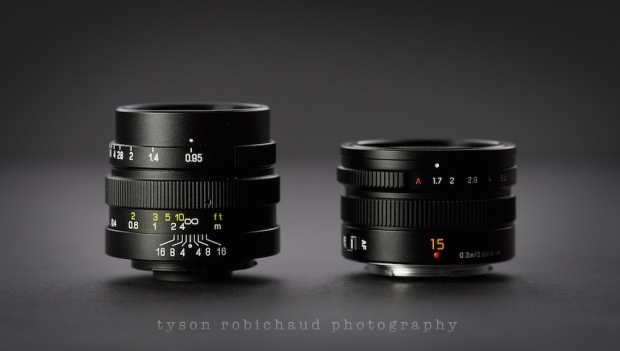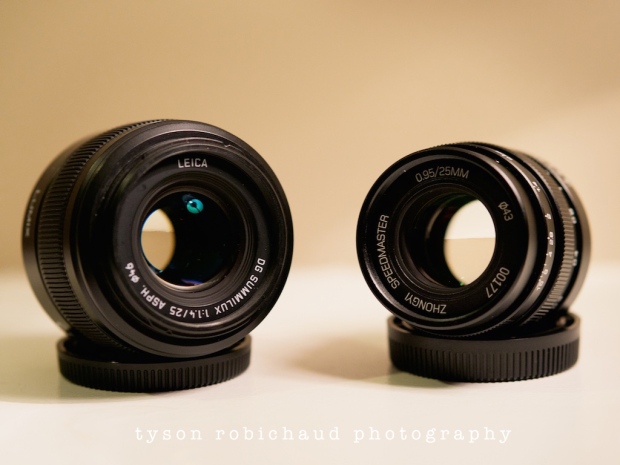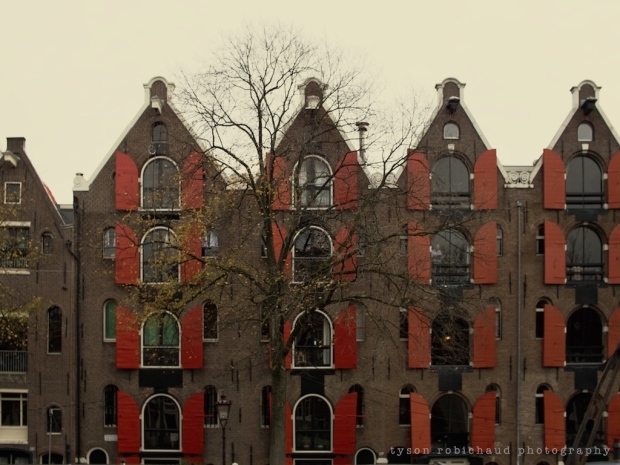Small, sharp, fast, relatively light and comparably inexpensive. All things I love in a lens. ZY Optics has produced yet another ultra fast option for micro 4/3 shooters, but a first option available in a dedicated mount, faster than f/1.4, new for under $400.
The question now stands, how does this fit in with all the other standard/normal lens offerings within the micro 4/3 landscape? Well, more easily than you might think. While not perfect, it definitely has enough going for it to justify a look. C’mon in for my thoughts and some tests against the Pana-Leica 25mm f/1.4 Summilux…
I preordered this lens as soon as I heard about it over on 43rumors.com because I do love the ability to employ very fast lenses, and at the going price, it seemed worth a go. The lens showed up in quite the box, leather clad with a custom foam insert and a small booklet that in no way makes any sense to anyone that doesn’t speak and read Chinese (not sure if it’s Mandarin, or Cantonese as unfortunately, I do not yet understand either). Luckily for me, I’ve seen a few lenses in my time, so I knew how to use it. Three things immediately jumped out at me. First, this lens is solid. I’ll get into a little bit more detail below in the construction portion. Secondly, the focus and aperture rings are nicely dampened, but the aperture ring is clickless. A tick in the “pro” column if you’re a video shooter, but quite the opposite for me as a still shooter primarily. Third, the lens cap is crap. I mean, it’s fine and just like any other third party pinch cap it totally works, but I immediately found it difficult to seat properly as it shifted and sat imbalanced without some delicate placement. Luckily, a lens cap need only serve one function, to protect the front element when not in use, and while it is a little wonky, it does its job just fine.
You can find the ZY Optics Mitakon Speedmaster 25mm f/0.95 lens at my trusted partners, via my affiliate links for $399 HERE at Adorama and HERE at B&H Photo.
CONSTRUCTION
The aptly named Speedmaster is built well. Solid construction that has held up over the last three months that I’ve been shooting with it pretty extensively. It’s not weather sealed, but so few lenses actually are. I’ve had this lens out in a variety of conditions from some decent humidity to rain to sub freezing and while I have been cautious with it, it has seen a variety of somewhat inclement weather and so far has done well (I do suggest keeping a couple of those desiccant packets somewhere in your camera bag, along with a good sized ziplock for the times you may need to acclimate the camera from cold to warm environs). While nicely put together, I wouldn’t suggest taking this lens swimming with you.
I bought this lens to bring along on a European work trip, intending to use it on my GX8 (which I did quite a bit) but over the last couple months, it has found its way onto my GM1 more often, which is where I feel it really comes into its own being pretty discreet. In dimension, it is roughly the same diameter as the Pana-Leica 15mm f/1.7 and size of the Olympus 45mm f/1.8 that most of us have, have had, or at the very least know about, right? Where it differs though is in weight. A touch heavier than the PL 15mm, and noticeably heavier than the slight Oly, as the ZY Optics, Zhongyi Speedmaster Mitakon (I still don’t know exactly what to call this fricken thing, so I’ll just call it the Speedmaster because that makes sense and it sounds fairly cool) is made entirely of metal as opposed to the plastic housing from the Oly lens. That, and the glass involved in a lens this fast is always going to be more substantial than that of a slower optic. Saying that, it is claimed to be the lightest f/0.95 optic available on the market anywhere, and I’m not aware of any f/0.95 lens that can best its weight savings. A great mate to the system when looking for pure lens speed AND weight reduction.
The Speedmaster incorporates 11 elements in 9 groups, with one Extra Low Dispersion element, 4 Extra High Refractive Index elements and 2 High Refractive Index elements all adding up to well controlled CA and a surprisingly sharp image wide open. That said, when focused to infinity, I find that the image is unacceptably sharp until about f/5.6 or so (see comparison below). According to the ZY Optics website (here), this lens has 11 aperture blades… Well, either they’re lying, or they’ve secretly changed the construction of the lens, as mine only has 9.* I’ve made inquiry into this, and I’ll update as I hear back.
*ZY Optics has confirmed that the lens in fact does only have 9 aperture blades, and the statement on their website is a mistake according to my sales contact.
Olympus shooters, beware. This lens is listed as “incompatible” with the E-PL6, E-PL5, (E-PM1 via comments), E-PM2 and OM-D E-M5 Mark 1, which is unfortunate as I’m not aware of any other micro 4/3 lens being incompatible with any micro 4/3 camera body. By reading between the lines, it appears to be due to the staggered “step” bevel internally in those cameras. The Speedmaster does have its rear element extend a short distance behind the lens (you can kind of see it in the image above), so I assume it is an issue with that. Fortunately though, all other m4/3 bodies seem just fine.
The focus ring is nicely dampened, as is the clickless aperture ring. That said, for me, they’re too close together, and difficult to distinguish between. This isn’t quite an issue when I’m using the LCD/OLED screen to compose, but with my eye in the EVF, and being that I have pretty gangly fingers, it annoyed me more than once. Being clickless, it is very difficult to know where your aperture is set without looking at the lens itself. This is a large reason why I find it working better for me on the GM1 which is more a run and gun camera, the way I use it. No viewfinder, so I’m already composing and shooting using the LCD. I find that to work better for me, and while I enjoy this lens on the GX8, I found myself needing to take my eye out of the EVF quite often to make sure I didn’t adjust the aperture ring inadvertently between shots. The good side about a mirrorless camera is that we get to see the exposure change either on screen or through the EVF, so while annoying, adjusting the aperture will allow us to see how it affects our image in real time. If you like to use a tilting screen as a kind of waste level finder (which I really did with the EM5 and GX7) then I think this becomes far less of an issue, and can lend itself to a great street shooting lens as you can keep an eye on, and quickly adjust from that bird’s eye view.
PERFORMANCE
Below, you’ll find a couple setups where I worked my way through the aperture range. First up, amazingly, I found the same exact bike this year in Amsterdam that I shot when doing a similar optical test last year with the Voigtländer Nokton 42.5mm f/0.95 lens (see that review here) so that was pretty cool. The point of focus is the “A” in Amarone on the right (actually the smaller text just above the A).
Click to see full sized
Going through the aperture range at a very close focusing distance, it shows me first how sharp this lens is capable of being, even wide open, and secondly how shallow I can get the depth of field if wanting to do intimate portraits, detail vignette shots or the like. The bokeh rendering in oof highlights is very cat-eyed, wide open but rounds out nicely at f/1.4 before starting to show the edges of the aperture blades when stopped down further.
Next, I wanted to look at focusing a bit further away, but not quite to infinity. JC stood in for me as my focal point, and stood about 20-25 feet away from where the tripod was at. First the frame as it was captured at all apertures, and then 100% crops at each, listed aperture.
Click to see full sized
When focusing on subjects between about 10-30 feet (and even when focused out to infinity) I’ve noticed that this lens struggles a little bit. Maybe it’s my copy, maybe it’s the lens design, but within 10 feet from the camera, this lens is remarkably sharp in the center. Beyond that, it needs to be stopped down to about f/2.8 to get a more crisp focus between 10-30 feet, and about f/5.6 when focused to infinity in my tests. A nice, intimate portrait lens, but perhaps not great if wanting to shoot street or landscape type stuff where you’d be focusing beyond 10′, wanting to use this lens wider than f/2.8.
25mm COMPARISON
While I wish I had all available 25mm lenses available to me to compare and test against one another, I do have the Leica Summilux 25mm f/1.4 which is arguably one of, if not the best tested standard prime available for the system. Below I wanted to leave out all the feels and compare these lenses in two situations. One, focusing close to see sharpness and a little bokeh, secondly focused out to infinity. Nothing fancy, nothing exciting, just looking to see just how well it holds up in sharpness, and how hindered the Speedmaster might be when focusing on truly distant objects.
For all of these shots, I used manual focusing, average metering, aperture priority and the two second timer while the GX8 was on the tripod.
First, our close focus test. The full image, wide open for each lens as captured on top, followed by 100% crops at each listed aperture setting.
Click to see full size
Now, with both lenses focused to infinity (looking at the distant tree ~ 250-300′ away center frame)
Click to see full size
In the first comparison, the Leica outresolves the Speedmaster handily, but the Speedmaster is far from soft. In fact, it is really sharp, even wide open to my eye, just not quite capable of resolving at the same level that the PL 25/1.4 is.
In the second comparison, when focused to infinity, the Speedmaster is a mess and doesn’t get close to sharp at infinity until around f/5.6, but still nowhere near the Leica. It appears as if my lens does not allow the lens to fully focus all the way out to infinity, as it does appear to stop a shade before the focal point mark hitting that infinity mark on the focus scale. This would back up the visual evidence that the lens is not able to image distant objects at infinity as sharp until the lens is stopped down enough to allow the hyperfocal distance to catch up.** That said, the Speedmaster does seem to do a much better job at handling CA where the Leica looks pretty bad at larger apertures. Still, I’d take sharpness and resolution here when shooting, focused out to infinity.
**I am currently in discussion with ZY Optics to see if I can exchange this copy with one that properly focuses to infinity.
SAMPLE IMAGES
The “normal” focal length tends to be one that many people gravitate toward for an all around, everyday type lens. It may be a bit tight for larger group shots indoors, or might not be long enough to start picking out distant subjects, but most standard/normal prime lenses have a couple things going for them. First, they’re normally very sharp as the optical formulation is well explored being a bread and butter focal length for most camera and lens manufacturers, and secondly they’re usually a very affordable way to get a fast lens, comparable to many other more specialized focal lengths. Most all systems offer at least one standard prime faster than f/2.
There is absolutely no shortage of options when it comes to a normal/standard focal length equivalent lens for the micro 4/3 system. A “normal” focal length for a format is one that measures roughly the same as the diagonal measurement of the capture medium. For micro 4/3, that is roughly 22mm, so between 20-25mm would be considered “normal” or “standard” as it applies to this format.
From Olympus, we have a solid performer:
From Panasonic we have 3 options:
- Lumix 20mm f/1.7 $268 (Click here to see at Adorama, and here at B&H)
- Lumix 25mm f/1.7 $249 (Click here to see at Adorama, and here at
B&H not currently available) - Pana-Leica 25mm f/1.4 Summilux $598 (Click here to see at Adorama, and here at B&H)
From Voigtländer we have the other manual focusing, light vacuum:
So, what does this Speedmaster bring to the table compared to the many other options? Well, it ties the Nokton as the fastest standard lens for the system (and most any system), but at half the price. The Speedmaster does not have the ability to change to a click stop aperture, which the Voigtländer Nokton does, but it’s also less than half the weight and overall size, and I’d wager the Speedmaster is sharper wide open (at closer focusing distances anyway). I don’t have the Nokton around to test against, but from my experience, the Noktons aren’t quite tack sharp wide open while the Speedmaster borders on tacky sharpness from the word go.
If you want, or need auto focus, you’re in luck. You can choose any one of the four others from Olympus or Panasonic, depending on whether you prefer a slightly wider angle of view (in the case of the Lumix 20mm), or extra speed provided in the f/1.7 or f/1.4 Panasonic offerings. A lot of good options.
I don’t want to plant an unfound seed of distrust here, but the potential quality control issue, assuming that my early copy is in fact defective in regards to the focus ring disallowing proper infinity focus, may be a concern. I hope that this is more to do with my lens surely being one of the initial run as I’d preordered immediately upon the announcement going out. I will update with a new article if I’m able to receive a new copy and can in fact show a new copy being able to remedy the problem I’m seeing. Outside of focusing issues beyond about 25′ though, this lens is a real gem, and one I would greatly like to hold on to.
You can find the ZY Optics Mitakon Speedmaster 25mm f/0.95 lens at my trusted partners, via my affiliate links for $399 HERE at Adorama and HERE at B&H Photo.
For the inevitable question of which grip I have added to my GM1, it’s a very cool, inexpensive ($10) option that you can see HERE. For questions on the wriststraps, I make them, and you can see more about them on the TRP Camera Strap page HERE if interested.
Thank you guys and gals for the read. I love playing around with this stuff, and enjoy trying to provide an impartial view to hopefully aid other micro 4/3 system shooters with a little insight and first hand research. I’ve got some more lens review and comparison articles coming up soon, along with some fun software stuff, so stay tuned.
To keep up you can add your email to receive articles as they’re released by adding it to the email bar at the top right of the page (on a computer) or below if you’re mobile browsing. Also, I’d love to connect via the socials, find me on Facebook, Twitter, Flickr and Instagram.
Happy shooting,
Tyson






















Pingback: *ZY Optics, Zhong Yi Mitakon Speedmaster 25mm f...
Another great review. Some wonderful images to accompany it too. The butterfly shot is lovely -as are the ones of your family and friends. You also have a great palate. 🙂
LikeLike
Thank you, sir. The Lagavulin is becoming a mainstay around here 🙂
LikeLike
I hadn’t heard a peep about this lens, so thank you for another of your customarily detailed, thorough, unbiased reviews. I must admit I wasn’t at all tempted until I saw your images. (But I suspect those say more about the photographer than about the lens?) Gorgeous work, Tyson.
LikeLike
Hi Heather! Yeah, this lens kinda disappeared a little bit, but I have been enjoying it. Originally I had thought that having the Lumix 20mm and this might just allow me to sell off the Pana-Leica 25mm f/1.4, but I don’t think I’m quite ready for that 🙂 I appreciate you stopping in to comment. Have an awesome weekend.
t
LikeLiked by 1 person
Thanks for another informative review.
I keep thinking about these sorts of lenses, but I almost never shoot like that. I’m a bad tourist, though I tried some of that in San Francisco a few weeks ago with the Panasonic 25mm f/1.7.
The instructions in the box of the ZY Optics lens were probably in Simplified Chinese, like 中国, over Traditional Chinese, like 中國.
It’s almost as difficult as reading Dutch or English. 😀
LikeLiked by 1 person
Dutch might just take the cake 🙂
LikeLike
Thank you for a great and informative review as always :D.
LikeLike
Thank you, much appreciated man.
LikeLike
Interesting, thanks for the thorough review, as always. If it’s gotta be done, I much prefer pixel-peeping actual pictures rather than reviewing test charts for the real apples-to-apples comparisons.
It looks to me like your lens may not actually be able to hit infinity focus. That is, it looks like a mechanical issue rather than an optical issue. The photo of the statue in front of the church isn’t nearly as good as the closer focus quality, as you say, but that second comparison with the PL @ infinity is just abysmally bad. And as you stop down, none of the really far branches actually improve much, but the ones in front of them start to sharpen up more quickly.
I suspect that any improvement that you’re seeing at infinity as you stop down to around f/8 is just the focal plane starting to hit the hyperfocal point.
I would look into that, maybe show the manufacturer your testing and ask them if you can get a replacement or if there are any adjustments you can make.
LikeLike
Hi Andrew,
I’d thought the same thing, and even attempted to take the lens partially apart (as I have for other “cheap” lenses I have owned) to adjust the focusing. The screws seemed to be epoxied/loctite’d in so I took it no further. I’ve emailed ZY to no avail, but should try again. I get the feeling that my lens is an early model (as evidenced by the 9 aperture blades vs their claim of 11), and when I bought mine, it was direct, as it was not yet available through B&H or Adorama.
I’ll update if and when I can get them to send a replacement.
thanks!
t
LikeLike
The lens seems to have a aperature of 1.4. When I go down from 2.8 to 0,95 the speed is only 4 and not 8 times faster. I compared it with a Nikkor 50 1.4. There is the is the same speed when theyare wide open. For less money I could get a Panasonic 25mm 1.4with autofocus.
LikeLike
That isn’t what I’m seeing. When comparing the PL25 f/1.4 to it, I found the comparable exposures, identical at the listed apertures (from f/1.4 and up). Going from f/2.8 to f/0.95 is 3 1/3 stops faster, so shutter speed would also need to adjust at that same increment. For instance, 1/1000 sec at f/2.8 would adjust to 1/100 at f/0.95 which has been consistent for me. Now, that said, I don’t know the actual T stop rating of this lens as I’ve not measured it scientifically, but I found it to eat the same amount of light as the Leica 25mm (which I think is rated as a t/1.6 or so) when adjusted to the same aperture where applicable.
I’m not sure where you’d find the Panasonic/Leica 25mm f/1.4 under $400, but if you do, I’d highly suggest grabbing it. It is a great lens.
Thanks for the read and comment.
Cheers,
Tyson
LikeLike
I guess you wanted to say 1/100 at 2.8 amd 1/1000 at 0.95. I used an Olympus E-M5II without Autoiso: 1/20 at 2.8 and 1/80 at 0.95. I repeated the test several times. I compared the Nikkor 50 1.4 with the Olympus 12-40 2.8 at 2.8 the same speed. In Europe the Mitakon is difficult to get and expensive. I ordered it in Poland for 475€ (sometimes 430€). A posting on the Zhongyi-website was quickly deleted. An email was never answered.
LikeLike
Yes, sorry. I had it backwards. That is really weird that you’re only seeing a two stop adjustment, on Aperture priority and a manual adjustment of ISO I’d assume. Something isn’t right there. I am sending my lens back in exchange for one that will hopefully enable proper mechanical ability to focus to infinity.
LikeLike
Thanks for answering. I am pretty shure because I checked this in two ways. The lens seems to small for a 0.95 lens. Especially the back lens has a very small diameter for a lens of this kind.
Cheers,
Bernhard
LikeLike
Thanks Bernhard,
I’ll re test this lens when I receive the replacement and have a closer look at shutter speed. I’m not an optical engineer, but I do believe that the rear element often can be designed to be smaller than the max aperture. Depending on the optical formulation, order of any aspherical elements and the way the light is focused (and placement of these groups in relationship to the aperture) the rear element’s physical measurement alone isn’t necessarily tied to the aperture’s measurement, but it is an interesting observation.
I appreciate your input and would love to link to any testing you’ve done to help further the review for those looking for information on this lens. Let me know if you do have anything posted, on Flickr, 500px, or a website. I would happily try to send people to you on this.
Cheers,
Tyson
LikeLiked by 1 person
Pingback: Mitakon Speedmaster 25mm f/0.95 Lens, Review – MirrorlessGear
About the actual aperture being 2.8: I’ve read a few other reviews and none found this problem. Maybe there is a issue with the aperture blades of your lens. Can you see the blades moving while you turn the ring to 0.95? If it does, the light gets in.
LikeLike
I was also surprised. The blades were moving and wide open. I did not say 2.8. To me it seems to have max. aperture of 1.4. Wide open the same shutterspeed as my Nikkor 50 at 1.4.
LikeLike
Did you get another one from zhongyi? For infinity problems I mean?
Ow and could you confirm ( or rather decline ) about that discussion whether it actually is a 0,95 or not?
Thanks 🙂
LikeLike
Haven’t received the fix/replacement yet. My lens did open to f/0.95, yes as evidenced to me by shutter speed when testing against the Leica.
Thanks for the read and comment,
t
LikeLiked by 1 person
Glad to hear! ( about the aperture I mean )
And i hope you’ll get that replacement anytime soon 🙂
Hahah thank you instead ;p
LikeLike
From your “bottle” test image, it seems to me that the Mitakon 25mm f0.95 is a bit wider than the Leica 25mm f1.4. Can you confirm this?
LikeLike
Hmmm, I did not notice it to be any wider or tighter by comparison. I sent the lens back and I’m expecting its replacement any day now. I’ll be retesting the two against each other again and I’ll look to see if there are any differences.
LikeLike
Did you ever get a replacement lens? I’m kind of interested in this, but it seems crazy that they can’t quickly replace a defective lens, especially for a web reviewer.
LikeLike
I did. It took quite a while, but it does seem to do better when focusing to infinity. Still soft, but better.
LikeLike
Hi does this fit snug against your camera? I am finding that the lens is a bit loose against mine and turns against the body slightly when i turn the focus ring back and forth which is annoying. Using it on my Panasonic GM1.
LikeLike
Hi Harshal! No, mine is very snug, but this is the second one I’ve used, my first returned for an inability to fully focus to infinity (the first was also a snug fit though). I think that while an amazing deal, ZY may have quality control tolerance issues.
Have you tried mounting it to another m4/3 cam? Other than that, have you tried to inspect the lens mount to see if there is anything that may have come lose which may cause a little play and movement?
If it’s affecting the image quality, I’d suggest contacting them, but otherwise, I do have lenses that have a very small amount of movement (for various different cameras) that I don’t think about as it doesn’t affect the quality of the image in any discernible way for me.
Hope that it’s just a case of a slightly mis cut mount that only allows slight play when focused, because as long as it doesn’t affect the distance from the sensor, the circular image circle should, in theory, still properly project the light onto the sensor and not cause any ill effects.
Cheers,
t
LikeLike
I got mine Tuesday and it seems okay. It’s a bit heavy on the GM5, despite being a good size for it. It seems logical that there is a bit of ultra-resolving compromise in such a tiny size but I noticed that the Panasonic/Leica lens doesn’t do all that well at f/0.95. My Four-Thirds Leica/Panasonic 25mm f/1.4 doesn’t either, although it is similar in size to the Mitakon’s box.
Zhong Yi obviously go all out. The translation is far from perfect and made me smile several times but other than being warned not to disassemble it, what do I need to know?
LikeLike
Make sure your lens can actually focus to infinity. My first lens stopped literally, just short but the replacement is a-ok.
LikeLike
I will check again, but it seems quite good across the whole focus range, although I only used it at f/8.0, just to get that 1970s feel again.
It’s been raining so much that I haven’t had much time with it. I hadn’t any chance outside with my old Olympus Zuiko 50mm f/1.8.
This got me thinking about Voigtländer f/1.4 lenses for Leica M-mount, also but my desire to re-live the 1970s will probably fade. Having a 50mm f/1.8 and a 135mm f/2.8 was very restrictive, even with ASA 400 film.
LikeLike
Hello,whats your opinion for this lens and the panasonic 20mm at f1.7 and f2?
LikeLike
Hi Sakis. I think the LUMIX 20mm f/1.7 is one of the true gems of the system personally. It’s fast, sharp and tiny. I think the 20mm is a wonderful all around lens. The Speedmaster is more a shooting experience than purely an optical marvel. While both are very small for the overall offering, the Speedmaster is definitely not near as pocketable as the 20. It’s also over a stop faster but obviously requires manual operation. I’d say the 20 is more versatile, while the Speedmaster is better for video, and of course offers the ability to let in more light.
As far as pure sharpness, the 20 does better at all applicable apertures, but when stopped down toward f/4 or smaller, the difference isn’t quite as noticeable unless really looking for it.
LikeLike
Would anyone happen to know the lens cap size for this Speedmaster? I ended up buying one through eBay without the lens cap.
LikeLike
I will have to look in the morning, but I want to say 46mm. Don’t quote me on that yet 😉
LikeLike
Thank you for such intensive review. Just ordered that lens. Very excited to try it out. The plan is to use it for b-rolls shooting and close up product photos.
LikeLike
Thanks for the read! I’m sure you’ll enjoy this lens.
LikeLike